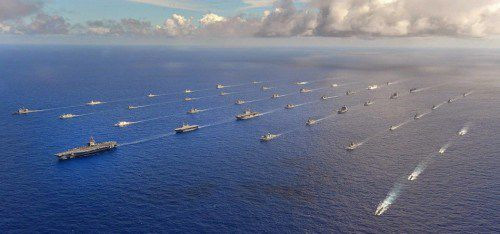Tense situation in the East Sea: US seeks to prevent China's tricks
(Baonghean) - The US will host a conference for the first time with the participation of military officials from 23 countries in an effort to build a coordinated amphibious force in the Asia-Pacific. This is one of many recent moves by the US to increase its military presence in the Asia-Pacific in the context of many seas in the region, especially in the East Sea, heating up with sovereignty disputes, making it impossible for the US to "sit still".
Increased military presence
The 23-nation Asia-Pacific military conference, convened by the US Marine Corps, officially began on May 18 in Hawaii. More than half of the countries from Asia will attend the conference, including those with “maritime sovereignty disputes” with China, such as Japan, the Philippines and Vietnam. However, China was not invited to attend this event. According to Reuters, a preparatory document pointed out that China was not invited to attend because the country is currently a competitor of the US and some countries attending the conference. US military officials said that this was nothing unusual. In 2014, China was present in the US-led Rim of the Pacific exercise with more than 20 other countries. However, China's participation was limited and mainly focused on search, rescue and humanitarian assistance activities.
Amphibious forces are specialized in maritime operations such as landing from ships and helicopters on the shore and are mobilized in cargo transportation, relief coordination, and disaster relief. In Hawaii, a spokesman for the US Marine Corps said the conference will discuss amphibious assault tactics, including attacks on rocky islands launched by warships and parachuting on rocky islands. Experts say the US Marine Corps plays a role in connecting amphibious forces in Asia and this will benefit many US allies such as Japan, South Korea and Australia.
 |
| Pacific Rim Exercise 2014. Photo from the Internet |
This is considered one of many recent moves by the US to increase its military presence in the Asia-Pacific region in the context of many seas in the region, especially in the East Sea, heating up with sovereignty disputes. Previously, Pentagon officials announced the content of the strategy to shift focus to the Asia-Pacific region, by 2020, accordingly, the US Navy and Air Force will deploy up to 60% of their forces in this region. In the future, the US will also "prioritize deployment" of some of the most advanced weapons to the Pacific, including the 5th generation fighter F-22 Raptor, Virginia-class attack submarines... Japan and the US have agreed to move about 9,000 Marines out of Okinawa Island (Japan) and transfer some of these 9,000 soldiers to Guam Island in the early 2020s.
Prevent tricksof China
In fact, the strategy of “pivoting” to Asia-Pacific was further promoted by the US administration during the second term of President Barack Obama. The two parallel strategies that the US is implementing are to increase its military presence and strengthen its alliances to contain China in the face of its rising ambitions. Especially in the context of maritime disputes between China and some Asian countries, the US cannot “sit still”.
The Pentagon said it is likely that “China is attempting to change the facts on the ground by improving its infrastructure in the South China Sea.” China claims sovereignty over about 90 percent of the South China Sea and is enforcing that claim by illegally building a chain of artificial islands on coral reefs in the Spratly Islands of Vietnam. Recent satellite images show that Beijing is accelerating land reclamation on seven reefs in the Spratly Islands and appears to be building an airstrip on one of the artificial islands. According to the commander of US forces in the region - Admiral Samuel Lockear, the artificial islands that China is illegally building in the South China Sea will allow Beijing to open bases and provide logistics for its large and growing maritime fleet.
The US admiral also warned of a more frightening prospect: China will eventually deploy radar systems and missiles to those artificial islands. This would pave the way for China to enforce an air defense identification zone in the South China Sea if it wants to establish such a zone. All these actions make the US unable to stand idly by, because Washington has declared that it wants to ensure freedom of navigation in the South China Sea - a lifeline for international merchant ships - in the context of fierce disputes there.
The US also reaffirmed its stance of not allowing China to manipulate the East Sea during US Secretary of State John Kerry's visit to Beijing on May 16-17. This visit by John Kerry was long planned to pave the way for the China-US Strategic and Economic Dialogue and the US visit by Chinese leader Xi Jinping, but amid the escalating tensions in the East Sea, this visit was dominated by maritime disputes. US Secretary of State Kerry conveyed the message that China's large-scale land reclamation activities and general behavior in the East Sea would damage the country's image, as well as its foreign relations with other countries, including the US.
The US-China leaders have long called for building relations between the two countries according to the model of a “new type of great power”, but in reality, there are still many disagreements and mutual wariness between Washington and Beijing, including competition for influence. Analysts say that China’s ambitions in the East Sea have “awakened” the US. The problem is how to deal with it, because so far, calls and warnings seem to have had no effect in stopping Beijing. The fact that the US organized this meeting of countries related to the East Sea without the presence of China shows that in the coming time, the US will not only increase its presence in this “hot” sea area, but will also take more drastic measures.
Thanh Huyen

.png)






